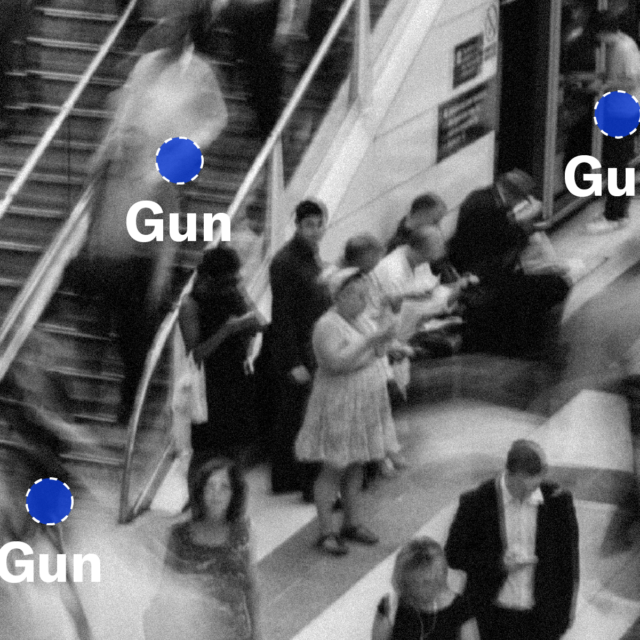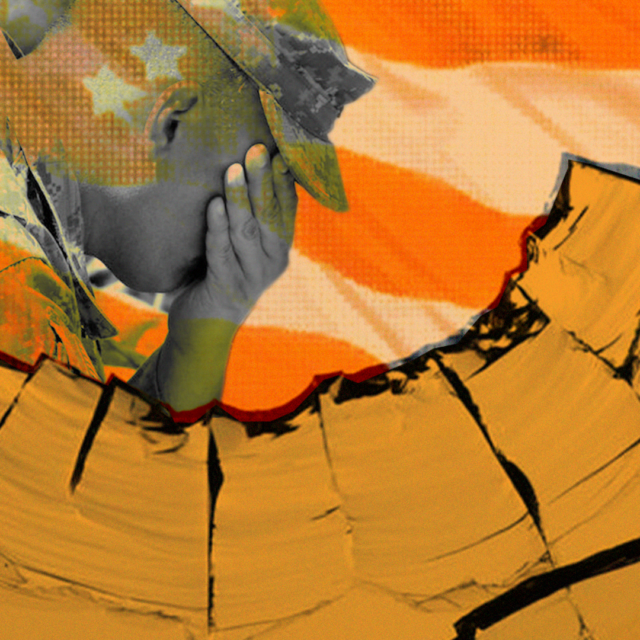Leer en español
Introduction

Lisa Espinosa’s 26-year-old son, Raymond “RJ” Pantoja, was shot and killed on April 10, 2016, in a senseless act of gun violence after he tried to stop an altercation outside a nightclub in Philadelphia. He died a hero. In honor of her son’s life, and particularly his love of music, Lisa founded Ray’s Rhythm for Justice Foundation, which provides performing arts scholarships for children who are affected by gun violence.
The 2022 mass shooting of 38 children and educators at Robb Elementary School1Jessica Schladebeck, “2 Victims Wounded in Robb Elementary School Shooting Slowly Improving,” New York Daily News, May 31, 2022, https://bit.ly/3AIZgZb.—a predominantly Latinx school in Uvalde, Texas290 percent of the student population at Robb Elementary School is Latinx. National Center for Education Statistics, “Robb El (NCES School ID: 484372004970,” accessed October 7, 2022, https://bit.ly/3RK7vZR.—shined a light on the devastating impact of gun violence in Latinx communities. Tragically, this was not the first time the Latinx community suffered incalculable loss from a mass shooting. In May 2016, a gunman entered Pulse, an LGBTQ+ nightclub holding a Latin night event in Orlando, Florida, where he shot 102 people, 49 fatally,3Alicia Melville-Smith et al., “A Shooting at a Gay Nightclub in Orlando Killed 49 People,” BuzzFeed News, June 21, 2016, https://bit.ly/2OqlfKp. the majority of whom were Latinx.4Some estimate that 90 percent of the victims of the Pulse mass shooting were Latinx. Steven W. Thrasher, “Latino Community Mourns Pulse Shooting Victims: ‘90% Were Hispanic’,” Guardian, June 14, 2016, https://bit.ly/3Mdl6aY. Three years later, 46 people were shot, 23 fatally, when a white supremacist gunman drove 10 hours to a Walmart in El Paso, Texas, to specifically target Latinx shoppers.5Cedar Attanasio, Jake Bleiberg, and Paul J. Weber, “Police: El Paso Shooting Suspect Said He Targeted Mexicans,” Associated Press, August 9, 2019, https://bit.ly/3fGjES8; Julio-Cesar Chavez, “Death Toll Reaches 23 From Last Year’s Mass Shooting in El Paso, Texas,” Reuters, April 26, 2020, https://reut.rs/3CfUly8. While these are highly visible incidents that gained significant attention, Latinx people in the United States are dying from gun violence every day and at rates disproportionate to their peers.
Why We Use Latinx
Developed within queer and trans communities, the term Latinx is a gender-neutral word designed to be inclusive of gender-fluid, gender-expansive, and/or gender nonbinary people, as well as other queer and trans communities on the gender spectrum.
Often used interchangeably, “Latinx” and “Hispanic” have different meanings: Latinx refers to people of Latin American origin, while Hispanic refers to people of Spanish-speaking origin. Latinx is used here when we are referring to both Hispanic and Latinx communities, and Hispanic is used otherwise.
Gun Violence in Latinx Communities
5,300
Each year, nearly 5,300 Latinx people die from gun violence in the US.
Everytown Research analysis of CDC, WONDER, Provisional Mortality Statistics, Multiple Cause of Death, 2019–2023. Latinx defined as all races of Latinx origin.
Last updated: 11.8.2024
Each year, nearly 5,300 Latinx people die from gun violence in the United States—an average of 14 deaths every day6Centers for Disease Control and Prevention, National Center for Health Statistics. WONDER Online Database, Provisional Mortality Statistics, Multiple Cause of Death (accessed September 1, 2024). Average: 2019 to 2023. Latinx defined as all races of Latinx origin.—and 13,300 are shot and wounded.7Everytown for Gun Safety Support Fund, “A More Complete Picture: The Contours of Gun Injury in the United States,” December 2020, https://every.tw/33Hto3F. Six in 10 gun deaths among Latinx people in the United States are homicides, and Latinx people are more than two times more likely to die by gun homicide and four times more likely to be wounded by an assault with a gun than white people.8Centers for Disease Control and Prevention, National Center for Health Statistics. WONDER Online Database, Provisional Mortality Statistics, Multiple Cause of Death (accessed September 1, 2024). Average: 2019 to 2023. Latinx defined as all races of Latinx origin. White defined as non-Latinx origin. Homicide includes shootings by police; Everytown for Gun Safety Support Fund, “A More Complete Picture: The Contours of Gun Injury in the United States,” December 2020, https://every.tw/33Hto3F.
In cities, the majority of gun homicides affect young Black and Latino men in historically underfunded neighborhoods.9Everytown for Gun Safety, “City Gun Violence,” accessed September 1, 2021, https://www.everytown.org/issues/city-gun-violence. During the first two years of the COVID-19 pandemic, when gun violence surged the rate of gun deaths among Latinx people increased 21 percent from 2019 to 2020, and another 13 percent from 2020 to 2021.10Centers for Disease Control and Prevention, National Center for Health Statistics, WONDER Online Database, Underlying Cause of Death. A percent change was developed using 2019, 2020, and 2021 age-adjusted rates. Latinx communities in cities experienced an even greater burden; an analysis of nine US cities found that more than 85 percent of the 2020 increase in gun violence in those cities occurred in predominantly Black and Latinx neighborhoods.11Weihua Li and Beth Schwartzapfel, “Murders Rose Last Year. Black and Hispanic Neighborhoods Were Hit Hardest,” Marshall Project, April 8, 2021, https://www.themarshallproject.org/2021/04/08/murders-rose-last-year-black-and-hispanic-neighborhoods-were-hit-hardest.
Gun Deaths Among Latinx People
Last updated: 11.8.2024
The burden of gun violence is also borne by Latinx children and teens, who are more than three times more likely to be killed by gun homicide than their white peers12Centers for Disease Control and Prevention, National Center for Health Statistics. WONDER Online Database, Provisional Mortality Statistics, Multiple Cause of Death (accessed September 1, 2024). Average: 2019 to 2023. Ages: 0–19. Latinx defined as all races of Latinx origin. White defined as non-Latinx origin. Homicide includes shootings by police. and are also more likely to be exposed to violence in cities.13Gregory M. Zimmerman and Steven F. Messner, “Individual, Family Background, and Contextual Explanations of Racial and Ethnic Disparities in Youths’ Exposure to Violence,” American Journal of Public Health 103, no. 3 (March 2013): 435-42, https://ajph.aphapublications.org/doi/10.2105/AJPH.2012.300931. Latinx children and teens are also increasingly impacted by firearm suicide. Each year, more than 190 Latinx children and teens die by firearm suicide,14Centers for Disease Control and Prevention, National Center for Health Statistics. WONDER Online Database, Provisional Mortality Statistics, Multiple Cause of Death (accessed September 1, 2024). Average: 2019 to 2023. Ages: 0–19. Latinx defined as all races of Latinx origin. and the rate of gun suicide among this population has increased 121 percent over the past decade—higher than the increase among young people overall.15Everytown Research analysis of Centers for Disease Control and Prevention, National Center for Health Statistics, WONDER Online Database, Final Mortality Statistics, Underlying Cause of Death, 2014 and Provisional Mortality Statistics, Multiple Cause of Death, 2023 (accessed September 30, 2024). Rate percent change: 2014 vs. 2023. Ages: 0–19. Latinx defined as all races of Latinx origin.
Latinx people in the US have historically been impacted by discriminatory policies and attitudes16 Mark Hugo Lopez, Ana Gonzalez-Barrera, and Jens Manuel Krogstad, “More Latinos Have Serious Concerns about Their Place in America Under Trump,” Pew Research Center, October 25, 2018, https://pewrsr.ch/2GHgqfH. See also Mary G. Findling et al., “Discrimination in the United States: Experience of Latinos,” Health Services Research 54 (October 30, 2019): 1475-6773, https://onlinelibrary.wiley.com/doi/full/10.1111/1475-6773.13216; Joanna Almeida et al., “The Association between Anti-Immigrant Policies and Perceived Discrimination among Latinos in the US: A Multilevel Analysis,” Population Health 2 (December 2016): 897–903, https://www.sciencedirect.com/science/article/pii/S2352827316301471. and were victimized by hate-motivated violence long before the mass shooting in El Paso. Research has found that increases in anti-Hispanic hate crimes followed increases in Hispanic immigration.17Michele Stacey, Kristin Carbone-López, and Richard Rosenfeld, “Demographic Change and Ethnically Motivated Crime: The Impact of Immigration on Anti-Hispanic Hate Crime in the United States,” Journal of Contemporary Criminal Justice 27, no. 3 (August 2011): 278–98, https://doi.org/10.1177/1043986211412560. A Department of Justice report found that Hispanic people experienced a higher rate of violent hate crime victimization than both white and Black people in the last five years studied.18Madeline Masucci and Lynn Langton, “Hate Crime Victimization, 2004-2015,” US Department of Justice, Bureau of Justice Statistics, June 2017, https://bit.ly/2ZmfP9X. Bias against Latinx people, amplified by anti-immigrant policies and language from the past presidential administration, causes direct harm. A 2019 report found that 10 percent of Latinx adults had been victimized by a hate crime in the past year, though only 8 percent of those victimized felt comfortable reporting the crime to police.19Carlos A. Cuevas et al., “Understanding and Measuring Bias Victimization against Latinos,” National Criminal Justice Reference Service, October 2019, https://bit.ly/3jiDgbq.
While gun violence clearly disproportionately affects Latinx people in the United States, the true scope of the impact is difficult to see. Hispanic people are more likely to have their ethnicity miscategorized in mortality data than white or Black people, and this issue is compounded for certain Hispanic identities.20Elizabeth Arias, Melonie Heron, and Jahn K. Hakes, “The Validity of Race and Hispanic-Origin Reporting on Death Certificates in the United States: An Update,” August 2016, https://stacks.cdc.gov/view/cdc/45533. Additionally, the diversity of Hispanic or Latinx identities—it is the largest US ethnic group21US Census Bureau, “QuickFacts: United States,” accessed August 21, 2020, https://bit.ly/2Ed8bqU. and includes people of all races—means that understanding exactly how gun violence impacts specific Latinx communities is limited by insufficient collection of race and ethnicity data.22US Census Bureau, “Research to Improve Data on Race and Ethnicity,” accessed August 21, 2020, https://bit.ly/34mE8HN. See also Mark Hugo Lopez, Jens Manuel Krogstad, and Jeffrey S. Passel, “Who Is Hispanic?” Pew Research Center, November 11, 2019, https://pewrsr.ch/3aSkR2s. Consequently, the full impact of gun violence among Latinx people in cities, states, and communities across the United States is unknown.
The Disproportionate Impact of Police Violence
Latinx people are also disproportionately impacted by police violence. In an average year, police shoot and kill nearly 200 Latinx people, and at a rate higher than white people.23Everytown Research analysis of Mapping Police Violence 2020 to 2024, (accessed January 22, 2025) and US Census Bureau, (accessed January 22, 2024), https://data.census.gov/cedsci/table?hidePreview=true&tid=ACSDT1Y2019.B03002. On average, police shot and killed 198 Latinx Americans per year; this is a rate of 3.2 fatal police shootings per million Latinx Americans. During the same time, police shot and killed an average of 497 non-Latinx white Americans each year; this is a rate of 2.5 per million non-Latinx whites—1.3 times more Latinx people than white people. And police are twice as likely to threaten or use physical force during encounters with Latinx people than with white people.24Elizabeth Davis, Anthony Whyde, and Lynn Langton, “Contacts between Police and the Public, 2015,” Bureau of Justice Statistics, October 2018, https://www.bjs.gov/content/pub/pdf/cpp15.pdf; Floyd v. City of N.Y., 959 F. Supp. 2d 540 (United States District Court for the Southern District of New York, August 12, 2013). As a consequence, many Latinx people may not feel assured that law enforcement would protect them, and Latinx people generally report less confidence in police than white people.25Jens Manuel Krogstad, “Latino Confidence in Local Police Lower Than among Whites,” Pew Research Center, August 24, 2014, https://www.pewresearch.org/fact-tank/2014/08/28/latino-confidence-in-local-police-lower-than-among-whites/. Young Latinx students are also more likely to face negative academic repercussions due to policing in schools, and they are more likely to be arrested than their white peers.26Deborah Fowler et al., “Dangerous Discipline: How Texas Schools Are Relying on Law Enforcement, Courts, and Juvenile Probation to Discipline Students,” Texas Appleseed and Texans Care for Children, December 14, 2016, https://report.texasappleseed.org/dangerous-discipline/.
Deteriorated relationships between Latinx communities and law enforcement also present challenges in reporting and solving crimes. Police violence dramatically reduces public confidence in law enforcement, leading community members to see them as part of the problem.27Everytown for Gun Safety Support Fund, “Gun Violence and the Police,” June 29, 2020, https://everytownresearch.org/report/gun-violence-and-the-police/. Additionally, certain cultural elements shared by many members of the Latinx community, including histories of dictatorial leadership in Latin America and demographic status in the US, make many Latinx people wary of law enforcement.28See, e.g., Nicole Santa Cruz, Ruben Vives, and Marisa Gerber, “Why the Deaths of Latinos at the Hands of Police Haven’t Drawn as Much Attention,” Los Angeles Times, July 18, 2015, https://lat.ms/2DHWXKH.
Aggressive federal immigration policies have caused a chilling effect on willingness to talk to police among Latinx people, and law enforcement’s role in immigration enforcement also erodes Latinx individuals’ trust in police.29Hamutal Bernstein et al., “Adults in Immigrant Families Report Avoiding Routine Activities Because of Immigration Concerns,” Urban Institute, July 2019, https://urbn.is/3bJuErK; Kelle Varrick, “Latino Confidence in the Police: The Role of Immigration Enforcement, Assimilation, and Immigration Status,” Journal of Ethnicity in Criminal Justice 12, no. 4 (October 2, 2014): 289–307, https://doi.org/10.1080/15377938.2014.893218; Krogstad, “Latino Confidence in Local Police Lower Than among Whites.” Hispanic immigrants, particularly undocumented Hispanic immigrants, are less likely to report being victimized by a crime,30Stefano Comino, Giovanni Mastrobuoni, and Antonio Nicolò, “Silence of the Innocents: Illegal Immigrants’ Underreporting of Crime and Their Victimization,” SSRN Scholarly Paper, Social Science Research Network, October 31, 2016, https://papers.ssrn.com/abstract=2861091. and fear of police inquiries into their immigration status or the status of someone they know has also made US-born Latinx people less likely to report victimization.31Nik Theodore, “Insecure Communities: Latino Perceptions of Police Involvement in Immigration Enforcement,” Department of Urban Planning and Policy, University of Illinois at Chicago, May 2013, https://bit.ly/3m7VNK3. Practices like Immigration and Customs Enforcement officers appearing at hearings for protective orders have made immigrant domestic abuse survivors less likely to report the abuse,32Tahirih Justice Center et al., “Immigrant Survivors Fear Reporting Violence,” June 2019, https://bit.ly/2IWgp5U (national survey finding that three out of four advocates and attorneys reported that immigrant domestic abuse survivors have concerns about going to court for a matter related to the abuser/offender, and over 76 percent reported that immigrant survivors have concerns about contacting the police). and in their lifetime, approximately one in three Latina women have experienced intimate partner violence.33Matthew J. Breiding, Jieru Chen, and Michele C. Black, “Intimate Partner Violence in the United States—2010,” Centers for Disease Control and Prevention, National Center for Injury Prevention and Control, 2014, https://bit.ly/3RKcrxR. Additionally, more than three in 10 Latina homicides are committed by an intimate partner, and firearms account for 55 percent of the cause of these deaths.34Everytown Research analysis of Centers for Disease Control and Prevention, National Violent Death Reporting System (NVDRS), 2021. Ages 18–85+.
Policymakers Can Act to Protect Latinx Communities
Policymakers should address the disproportionate impact of gun violence on Latinx people in the United States with action, including by:
- Funding community-based violence intervention programs that work to reduce violence through targeted support and interventions for individuals at the highest risk of shooting or being shot. Local governments can utilize American Rescue Plan funds to support city gun violence prevention.
- Implementing policies that reduce gun violence by police. Law enforcement agencies should have strong guardrails on when police may use force against civilians, ensure police are held accountable when force is used, and prioritize de-escalation, dignity, and respect. Cities may also consider implementing alternative dispatch programs, which connect people in crisis with mental health and social services in difficult situations that police might not have the training to address.
- Prohibiting all people convicted of hate crimes from having guns. While a felony conviction prohibits gun possession under federal law, a hate crime misdemeanor conviction does not. This means that in half of US states, a person convicted of a violent hate crime could legally pass a background check and buy a gun.
- Passing Extreme Risk laws, which allow family members and law enforcement to ask a judge for an order to temporarily remove guns from a person who poses a serious risk of injuring others (or themselves) with a gun. This gives people in crisis a chance to seek help. Extreme Risk laws are proven to reduce rates of suicide and have shown success in preventing potential mass shootings.35Aaron J. Kivisto and Peter Lee Phalen, “Effects of Risk-Based Firearm Seizure Laws in Connecticut and Indiana on Suicide Rates, 1981–2015,” Psychiatric Services 69, no. 8 (August 2018): 855–62, https://doi.org/10.1176/appi.ps.201700250; Jeffrey W. Swanson et al., “Implementation and Effectiveness of Connecticut’s Risk-Based Gun Removal Law: Does It Prevent Suicides?,” Law and Contemporary Problems 80 (2017): 179–208, https://bit.ly/3gidLYO; Jeffrey W. Swanson et al., “Criminal Justice and Suicide Outcomes with Indiana’s Risk-Based Gun Seizure Law,” Journal of the American Academy of Psychiatry and the Law Online 47, no. 2 (2019): 188–97, http://hdl.handle.net/1805/22638; Garen J. Wintemute, “Extreme Risk Protection Orders Intended to Prevent Mass Shootings: A Case Series,” Annals of Internal Medicine 171 (2019): 655–58, https://doi.org/10.7326/M19-2162.
- Creating permanent state and local offices dedicated to gun violence prevention and research institutes with a mission to study and recommend policy solutions to combat gun violence, and putting a premium on new data collection infrastructure that can help policymakers to evaluate not only homicide, but also unintentional shootings, nonfatal assaults, and suicide.
Learn More:
Everytown Research & Policy is a program of Everytown for Gun Safety Support Fund, an independent, non-partisan organization dedicated to understanding and reducing gun violence. Everytown Research & Policy works to do so by conducting methodologically rigorous research, supporting evidence-based policies, and communicating this knowledge to the American public.



